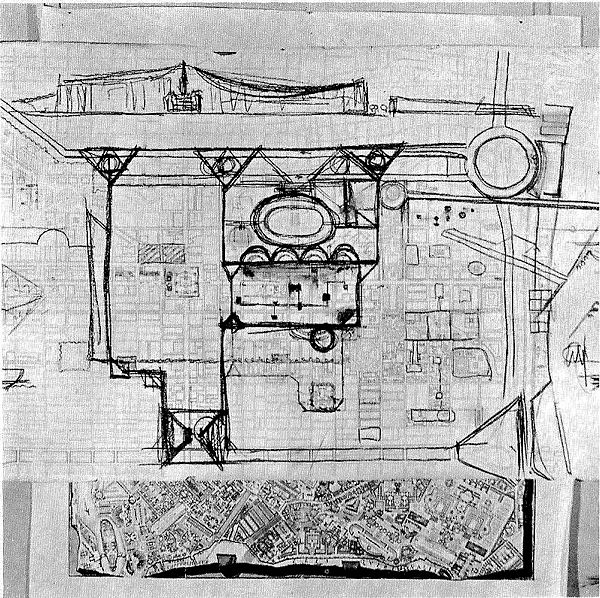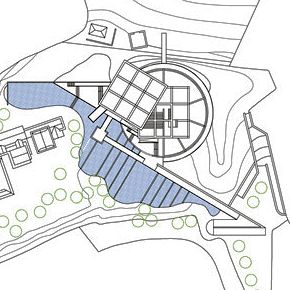Not so in the studies between the laboratories; their problem demanded a more complicated sequence of Form and Design, and its solution was again characteristic of Kahn. Early shape used were pure derivations from the fanning pattern of the lower peristyle of Domitian's palace of the Palatine or from the "Teatro Marittimo" of Hadrian's Villa. It will be recalled that Wright had long before adapted the plan of the villa as a whole for his Florida Southern College of 1939, and had used shapes from or related to it in later projects, while Le Corbusier had supplemented his sculptural Hellenic impulses with a series of drawings of the Villa's spaces which culminated in his top-lit megara at Ronchamp. More directly, the shapes used by Kahn can be found not only in Choisy but also infinitely repeated in the composite photostat of Giovanni Battista Piranesi's map of Rome, drawn by him for his book on the Campus Martius, probably of 1762, which now hangs in front of Kahn's desk. Nervi, too, has used this curvilinear pattern in some of his ribbed slabs. Kahn had intended to support the studies on columns which arose from the associated gardens at the lower level to grasp them about at the thirds of their arcs; but a further stage of design intervened: the scientists could not see the sea from these shapes. Thus they were modified and the present simpler forms grew out of them.
Patterns from Rome and, most particularly, from Ancient Rome as imagined by Piranesi at the very beginning of the modern age, have played a part in the process at the Meeting House as well. (An early sketch had been traced by a draftsman, partly as a joke, from a plan of one of the units of Hadrian's Villa itself. "That's it," said Kahn.) The major fountain splashes within a colonnade partly untrabeated, a ruin. Rounded shapes, to be found again and again in the Piranesi plan, and contrasting with the austere court inside, now push out from the main mass, recalling the splendid follies of 18th-century gardens but mightier than they: Walls "that nothing lives behind," shielding the glazed spaces from glare. They are to be constructed of pure concrete, reinforced and calculated, like the squat piers of the laboratory, against earthquake tremor.
Vincent Scully, Jr., Louis I. Kahn (New York: George Braziller, Inc., 1962). pp. 37-8.

Viaduct architecture for Philadelphia, Pennsylvania. 1962. Louis I. Kahn. Plan drawn over Piranesi's plan of the Campus Martius
| |
1997.02.08
Kahn's University of Tel-Aviv
...Kahn's design of the University of Tel-Aviv... ...its real connection to the Campo Marzio.
1997.08.28
"Redrawing History"
3. ...tracings of the various Mitchell/Giurgola plans.
4. ...a scale comparison between the Kahn plans and appropriate plans from the Campo Marzio.
1997.12.23
Campo Marzio introduction
I wanted to discover the secret of Piranesi's geometric planning dexterity--I wanted to find out how it could be possible to be as architecturally inventive as Piranesi. I also wanted to find out what Kahn learned from Piranesi.
1997.12.26
Ichnographia book - note 2
...the first time I learned of the Ichnographia and how it is inextricably linked to a story I learned about Louis Kahn. ...call attention to all the Kahn disciples in charge of my education. ...my thesis project (which is inspired by both Kahn and Stirling).
Cooper, Pratt, Vallhonrat and my first CAD training, Carles and 3-D, my two years at Penn--is not Piranesi based, but it contains many Kahn connections. ...my construction of the 3-D model of Center City as my entrée to Julia Converse and the Kahn Collection, and thus my first attempt of a CAD construction of an unbuilt architectural design. ...finally my uncanny meeting with Joseph Rykwert and his having worked on my drafting table.
Within months of leaving Penn I had my own CAD system, and that was when I began to redraw the Campo Marzio. As a very marginal member of the Philadelphia School, I don't see it as an unconnected avocation at all--more a kind of full circle scenario.
1998.11.23
articles for NOT THERE
The free use of the descriptive adjective "Piranesian" is used by Eisenman to freely and in so doing is misservicing the architectural community at large and Piranesi himself in particular. There is also the Venturi 1982 reference to Piranesian which I want to work in here as well.
1999.07.14
PMA + Quondam?
4. The Ichnographia Campus Martius in particular and Rome's Campo Marzio in general have a strong inspirational presence for Philadelphia's 20th century architects. A full scale reproduction of the Ichnographia Campus Martius hung over Louis Kahn's office desk throughout his mature career, and the title of Robert Venturi's and Denise Scott Brown's collection of essays A View from the Campidoglio taken literally is a indeed a view of the Campo Marzio. At least two prominent Philadelphia architects spent a lot of time "looking" at the Campo Marzio, and I see my long term commitment to redrawing and analyzing Piranesi's Ichnographia Campus Martius as a continuation and reenactment of the same Philadelphia architectural tradition.
| |
1999.09.24
since equinoctial augury
The Philadelphia and Rome connections do not always have to be evident, but I'm sure that enough interesting notions will arise. There are already good connections, the Ara Martis-Independence Mall coincidence, the Fairmount-Campidoglio coincidence, dies sanguinis, the Hadrian tomb-Logan Circle coincidence, cardo and decumanus (and this can compare to Eros and Thanatos).
Overall, this project will hold together because I have the Center City model and the Campo Marzio database, and I also have all the Rome books and the Philadelphia guide books. I just also remembered the Roma Interrotta connection via Giurgola and VRSB, and then also the general Kahn and Venturi Campo Marzio connection.
2000.01.17
Saarinen, Kahn and the Use of History
Paul wrote:
Kahn did not replicate images from history; he abstracted ideas.
Steve replies:
This remark may be somewhat misleading in that Kahn is noted for suggesting and exercising the notion of wrapping ruins around buildings.
I've never met Kahn, but practically all of my architectural teachers (at Temple U. in the mid to late 1970s) were taught by Kahn, or worked for Kahn, or both. I very much liked the architecture of Kahn; I liked the rigorous geometrics, and it is indeed via Kahn that I came to fetish Piranesi's Campo Marzio plan. In the summer of 1976 I purchased a special edition A+U book Kahn' work (for those that may not know, architecture books (and magazines) full of color images were still a rarity in the mid 1970s, and it was basically Japanese publishers that began to change all that). It seems there was a time when that book was not out of my sight.
In the summer of 1977, I went on an architectural study tour in Italy. I spent a whole afternoon on the Palatine Hill, walking through the Palaces of the Caesars. I saw 'Kahn' all over the Palatine Hill. Here's what I wrote then (right after my sophomore year).
Saturday, August 13, 1977
. . . We ended our tour on the Palatine Hill in the Palace of the Ceasars. The masonry structure is incredible. I want to go back alone and do a good study of it. There was so much to see and take note of that I was very discouraged to even start. (It was also too hot, but that's really no excuse.)
John [who was a graduate student from Penn also on the study trip] and I started to get into all of the structure. I was surprised to see how much [history] he really didn't know. I made a couple of references to Kahn, and I think he [John] was offended. (Too bad for him.) He said Kahn couldn't be limited to one period. I say, who's limiting him? It's obvious he [Kahn] took a great deal from the architecture of ancient Rome, and that's a fact that can't be disputed at all. I think he [Kahn] was wrong in doing it now that I see the ruins. Like India doesn't seem that great anymore, only the ruins are better, and his [Kahn's] plagiarism for Exeter almost makes me sick [how's that for a visceral reaction]. Wrap ruins around buildings my ass!!!
I really don't know what to think about architecture anymore.
Venturi - Kahn - Corbu - who the fuck knows???
Back to the 21st century...
What I like best so far about investigating reenactment in architecture, it the search for origins, that which is being reenacted, because it's in the origins that true originality resides. Kahn himself said he wished he could write 'Volume 0'. I'm not going to say that I too want to write 'Volume 0', but I do have real faith in its existence.
| |
2000.12.14
Language & Voice (and context)
...whenever I go to study an original edition of Piranesi's Campo Marzio publication, it is in a Frank Furness building, the Fine Arts Library of the University of Pennsylvania, the place where Louis Kahn held his design studios, and a building recently restored by Venturi, Scott Brown & Associates. Back in the mid-1980s, when I was employed as CAD system manager at U of P's Graduate School of Fine Arts, I had one the coveted balcony offices of Meyerson Hall which offer a majestic view of the Furness Fine Arts Library.
2001.07.25 12:18
Piranesi, Duchamp and Mustard
It was in Philadelphia May 1999 that the director of Quondam - A Virtual Museum of Architecture discovered that Piranesi's Ichnographia Campus Martius is actually a print executed in two (heretofore unknown) states. This discovery was made in the University of Pennsylvania's Fine Arts Library, a building designed by Frank Furness which in the 1960s housed Louis I Kahn's master architecture class and today houses the Louis I. Kahn Archives. The Piranesi Campo Marzio discovery occurred exactly between those two 'Kahn' spaces.

2002.12.17 17:25
Re: a Bemused Tadao Ando observation
I have studied the evolution of Kahn's architecture beyond Kahn since my own architecture thesis 1981, and Ando's Museum of Literature design appears to be a late descendant of Kahn via late 1970s Stirling and early 1980s Isozaki.
Kahn's Levy Memorial Playground designs with Isamu Noguchi (1961-66, unbuilt), and his Dominican Motherhouse of Saint Catherine de Ricci (1965-69, unbuilt) engendered much formal architectural play, a genealogy that goes mostly unnoticed by architectural historians. Much of Predock's, work, for example, especially "reenacts" the Levy Memorial Playground designs.
Interesting how you relate the Museum of Literature to a kind of themepark. It could easily be said that Kahn's formal playfulness was inspired by Piranesi's Ichnographia Campus Martius, an ultimate plan of an ancient Roman themepark if there ever was one.
|

